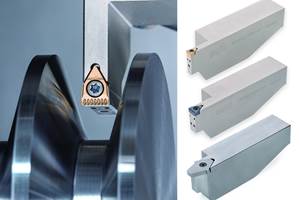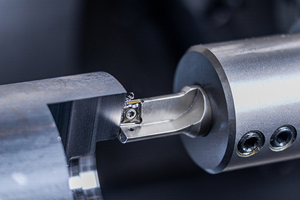Thermal Contraction Holds Tools Steady
When all is said and done, the intersection of a cutting tool and a workpiece is the point of metalworking. All process planning, employee training, capital investment and a host of other activities are links in a chain that lead to removing metal to make a part--chips.
When all is said and done, the intersection of a cutting tool and a workpiece is the point of metalworking. All process planning, employee training, capital investment and a host of other activities are links in a chain that lead to removing metal to make a part--chips.
Like any chain, each link has potential to cause failure. Strengthening the various links in the manufacturing chain is how businesses get better. Tooling Innovations (Bad Axe, Michigan) is offering a system to help improve one metalworking link between a cutting tool and toolholder.
Their system is called the Shrinker. It's elegant in its simplicity. For high speed, high accuracy machining, significant improvements in run-out, rigidity, balance, and gripping power can be realized from this thermal contraction toolholding system.
The concept is simple. Most of us are familiar with the principle of thermal expansion and contraction as applied to metalworking. Basically, it states that materials grow or shrink at a predictable amount and rate based on temperature variations.
Tooling Innovations has put this principle to work for shops in the form of a temperature actuated toolholding system. Each Shrinker toolholder has an ID bore that is slightly smaller than the cutting tool shank diameter. For example, if the cutter is a 0.5-inch end mill, the toolholder bore will be just less than 0.5-inch diameter.
To prepare the toolholder to accept the cutting tool, an off-line induction heating unit is used. The cutting tool end of the holder is heated, which expands the bore diameter. After a few seconds of heat, the toolholder has grown sufficiently to allow the cutting tool to slip into the bore.
As the toolholder cools, it contracts around the tool, gripping it firmly. A typical induction heat cycle takes about seven seconds. A timer on the induction unit will vary the induction heat cycle to accommodate different tool sizes.
After the induction cycle is complete, the tool is placed in an aluminum cooling block which quickly dissipates residual heat so the toolholder and cutting tool can be qualified before returning to the machine tool.
The process is reversed to remove the tool. The toolholder is again heated until it expands sufficiently to release the cutting tool. Total heating and cooling cycle is about 30 seconds.
The thermal contraction exerts upwards of 10,00 pounds of pressure. This compares to a drawbar force of 6,000 pounds on a typical machining center.
Gripping strength is uniform, pressing the tool from 360 degrees and over the full contact area between shank and holder. This shrink fit design automatically centers the cutting tool shank in the toolholder bore.
Any rotary tool application can use this toolholder. End mills, drills, reamers and bores in any cutting tool material, such as solid carbide and high-speed steel, are acceptable for this toolholding system.
In effect, the connection created using the shrink fit method is close to an integral tool shank in rigidity. This rigid connection translates to concentricity of 0.0002 inch. Shrinker toolholders are manufactured for high speed application. Balance pockets are machined in the drive keys for V-flange holders. Each holder is dynamically balanced using a two-plane Hoffman balancing machine.
Standard toolholders are balanced to G 2.5 at 20,000 rpm. Special tools have been manufactured to G 1.0 at 40,000 rpm. With no setscrews or moving parts the holders remain balanced leaving the cutting tool as the only variable.
In operation, concentricity reduces tool runout and precision balance reduces chatter. Cutters last longer (the company claims 100 percent increases and more) because chip load is evenly distributed on each cutting edge. The tool nose is narrow for machining pockets and recesses.
Shrinker's clean, simple design allows for the use of through the tool coolant for high speed applications. Since the tool is held without a mechanical mechanism, there is nothing to impede coolant passing through the toolholder, through the tool and into the cutting zone.
Thermal contraction technology used on Shrinker will work on any toolholder configuration. V-flange, CAT, HSK, Morse and others can use shrink fit to hold tools.
Ten years of field testing has resulted in no failures due to metal fatigue. Temperatures used on the induction unit are well below the temper for cutting tools. Generally cutters are heated above 1,000 degrees to harden their edges. The induction heat cycle needed to contract or expand the toolholder operates in a temperature range of 300 to 500 degrees.
The initial investment for this toolholder system is relatively high because the induction heating unit is included. Individual toolholders are generally less expensive than comparable collets, hydraulic holders and milling chucks. Payback rate is also increased in the form of longer cutter life, higher production rates, and simplified tool handling. GCK
Related Content
Lyndex-Nikken Toolholders Offer Stable, Versatile Machining
Polygonal shank toolholders provide a rigid connection between the tool and machine — ideal for all processes both in turning and milling.
Read MoreTungaloy Grooving Toolholders Provide Highly Stable Machining
TungHeavyGroove includes an enhanced insert clamping design for maximum tool rigidity.
Read MoreBig Daishowa Chuck Eliminates Chatter in Milling Operations
The Mega 12DS chuck is designed for trochoidal milling with anti-vibration end mills.
Read MoreCeratizit's Updated Tooling Solutions Improve Machining Performance
The company has upgraded its EcoCut indexable inserts lineup, as well as introduced two new toolholding and workholding solutions.
Read MoreRead Next
The Future of High Feed Milling in Modern Manufacturing
Achieve higher metal removal rates and enhanced predictability with ISCAR’s advanced high-feed milling tools — optimized for today’s competitive global market.
Read MoreIncreasing Productivity with Digitalization and AI
Job shops are implementing automation and digitalization into workflows to eliminate set up time and increase repeatability in production.
Read MoreIMTS 2024: Trends & Takeaways From the Modern Machine Shop Editorial Team
The Modern Machine Shop editorial team highlights their takeaways from IMTS 2024 in a video recap.
Read More

















.jpg;maxWidth=300;quality=90)







